I am excited to share with you two conference reports for our MMMP Blog, the first from 19th Rhythm Perception and Production Workshop (RPPW), Nottingham (UK) in June and the second from the 6th World Parkinson Congress in Barcelona (Spain).
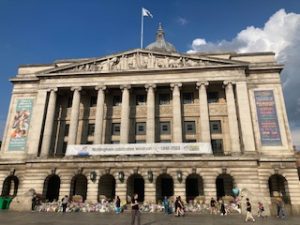
Flowers outside Nottingham Town Hall
RPPW was held in Nottingham from 19th to 22nd June at Nottingham Trent University.
It was not long after the awful shooting and the town was understandably a little quieter than usual but still beautiful and a wonderful place to visit. I even managed to go and see Strictly Ballroom featuring Kevin Clifton which was a spectacular show!
RPPW is a very specialised conference that focuses specifically on the science of rhythm, whether that be neuroscience, movement science, or music psychology. I was lucky to be able to attend with colleagues from the Groove team also based at the Lucerne University of Applied Sciences and Arts, in Switzerland, Prof. Dr. Olivier Senn and his PhD student Toni Bechtold who were also presenting their inspiring work on the science of groove.
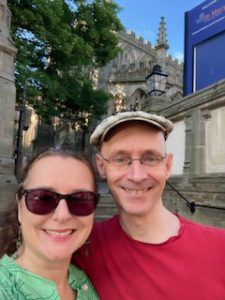
Dawn Rose and Oliver Senn, RPPW, Nottingham 2023
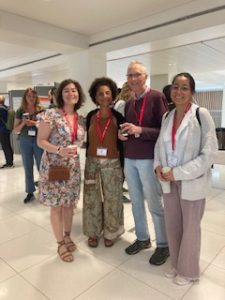
Lovely colleagues at RPPW (Left to Right), Dr Ségolène Guerín, Professor Yvonne Delevoye-Turrell, Professor Alan Wing, and PhD student Isabel Casso.
My talk was on behalf of my colleagues Marietta Ungerer (Lucerne University of Applied Sciences and Arts, Switzerland and University of Hertfordshire, UK) Sabrina Köchli (Lucerne University of Applied Sciences and Arts, Switzerland), Ellen Poliakoff (University of Manchester, UK), Will Young (University of Exeter, UK) & Michelle Phillips(Royal Northern College of Music, UK) and it was called Songlines for Parkinson’s: Exploring how people with Parkinson’s use music in everyday life and applying this within an interdisciplinary framework to co-develop a new music and movement-based intervention.
In scientific conferences we submit something called an Abstract which is then read by a team of experts (peer review) and if they decide the work is good enough, you are invited to present either as a spoken talk or as a poster.
Below is the abstract that was accepted for RPPW, and I was asked to present a talk in which I included videos and pictures from the development of Songlines. It was one of the few applied science and arts projects presented at the conference which tends to focus on experiments and statistically significant results. However, the audience did seem to enjoy seeing how the knowledge created in their laboratories is being put to good use to actually help people in real life.
RPPW Abstract
Although there have been a lot of studies about rhythm perception and production in Parkinson’s, little is known about how people with Parkinson’s (PwP) use music in everyday life. Similarly, there has been a lot of emphasis on the organisational properties of music in terms of rhythmic entrainment, sensorimotor synchronization and applications such as rhythmic auditory stimulation. However, as PwP tend to be up to 70% less active than their peers, and apathy is one of the main non-motor symptoms in Parkinson’s, it would be helpful to know which aspects of music PwP find motivational.
Here we report findings from an online survey conducted on the UK (N=217 PwP) demonstrating that a wide range of musical styles is appreciated, and that music is used for general aesthetic appreciation, motivation, and relaxation – but only 35% of PwP use music for walking. We also report the first music and dance sophistication figures for PwP and on their musical imagery ability as these are informative for future studies and applications.
We will also reflect on a series of interactive workshops conducted with PwP and a range of practitioners to explore 4 aspects of rhythm: tempo, repetition, synchronization, and syncopation in relation to potential rehabilitative mechanisms.
Finally, we will share details of our new co-developed protocol, a 12-week programme Songlines for Parkinson’s,along with our new method of capturing change over time in gait that integrates motion capture and a pressure sensitive gait mat to provide four-dimensional data – see Figure 1.

Figure 1
The World Parkinson Congress, known as WPC23, was held in the friendly, stylish and rich cultural centre of Barcelona from 4th to 7th July.
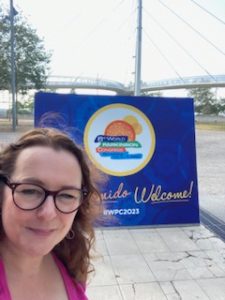 It is a very unusual conference because it is not just for scientists: here people with Parkinson’s are included as experts in their own right and invited to be a part of everything from organisers to presenters, artists, practitioners, care partners and special guests. The programme is jam packed with talks, posters, workshops and exhibiters showing everything to help people with Parkinson’s from specially woven sheets to physical aids and pharmaceuticals to shoe lazers! There were some amazing displays of artwork in the foyer as you can see from the pictures below – from stories from people with Parkinson’s laid out on the floor, to wonderful cartoons to bring advice to like and a beautiful quilt that everyone signed (including me!). There simply wasn’t enough time to see everything and meet everyone. It was the biggest and best conference I have ever been to.
It is a very unusual conference because it is not just for scientists: here people with Parkinson’s are included as experts in their own right and invited to be a part of everything from organisers to presenters, artists, practitioners, care partners and special guests. The programme is jam packed with talks, posters, workshops and exhibiters showing everything to help people with Parkinson’s from specially woven sheets to physical aids and pharmaceuticals to shoe lazers! There were some amazing displays of artwork in the foyer as you can see from the pictures below – from stories from people with Parkinson’s laid out on the floor, to wonderful cartoons to bring advice to like and a beautiful quilt that everyone signed (including me!). There simply wasn’t enough time to see everything and meet everyone. It was the biggest and best conference I have ever been to.
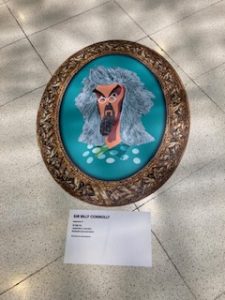
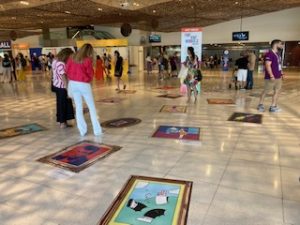
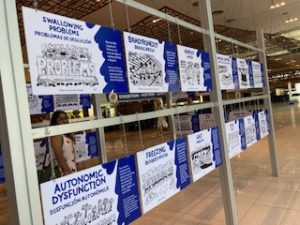
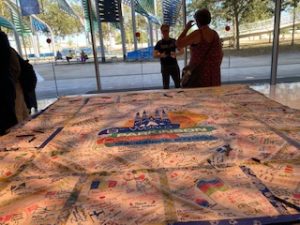
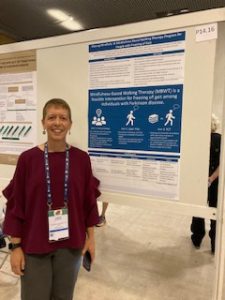
Gammon Earhart
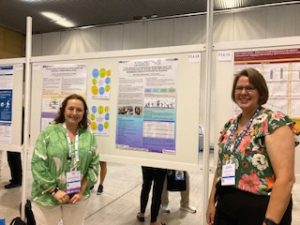
Me and Elizabeth Stegmoller
I presented two posters on the Thursday session, which was very exciting and busy and lasted for 3 hours! The poster ally I was in was amazing as all the famous people in the world of Parkinson’s arts-based therapeutic approaches were there, and I was placed in between the legendary Gammon Earhart (dance and Parkinson’s) and Elizabeth Stegmoller (singing and Parkinson’s)! I learnt so much by attending this conference and was delighted that so many people with Parkinson’s are interested in our project and approach to research.

Songlines Poster shown at WPC23
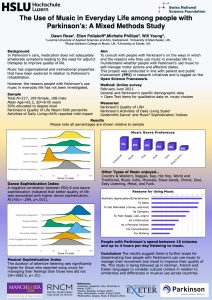
Use of Music among UK People with Parkinson’s Poster shown at WPC23
I had planned to take the weekend before and after the conferences as some holiday time and visited some fantastic places in surprisingly bearable heat! Here you can see the inside of the famous Sagra Familia – a cathedral designed by Gaudi. Inside he wanted to create the feeling of a forest of light using columns and stain glassed windows which evokes a wonderful atmoshere as I hope you can see in these pictures. I also did some walking tours (24,000 steps in one day!) and saw some beautiful parks (although none of the fountains were working due to a water shortage) and secret parts of the city including the hidden Roman columns (shown below).
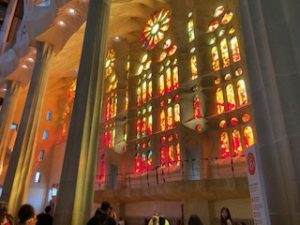
Inside Sagra Familia Cathedral
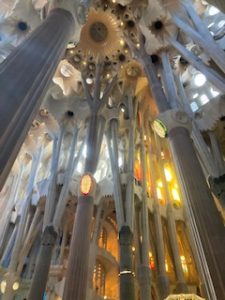
Columns that give the impression of a forest inside Sagra Familia Cathedral
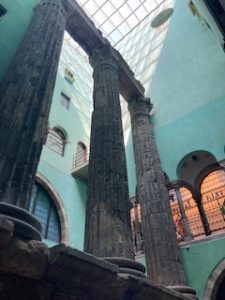
Hidden Roman Columns in the heart of Barcelona
I am so grateful to be able to meet so many amazing people and see such exciting places as part of my job – it is the best job ever to be able to do meaningful work, help people, and travel so I am happy to share these experiences here on our MMMP blog.
Until next time, Best wishes from Dawn Rose (MMMP Project Leader).


Schreibe einen Kommentar